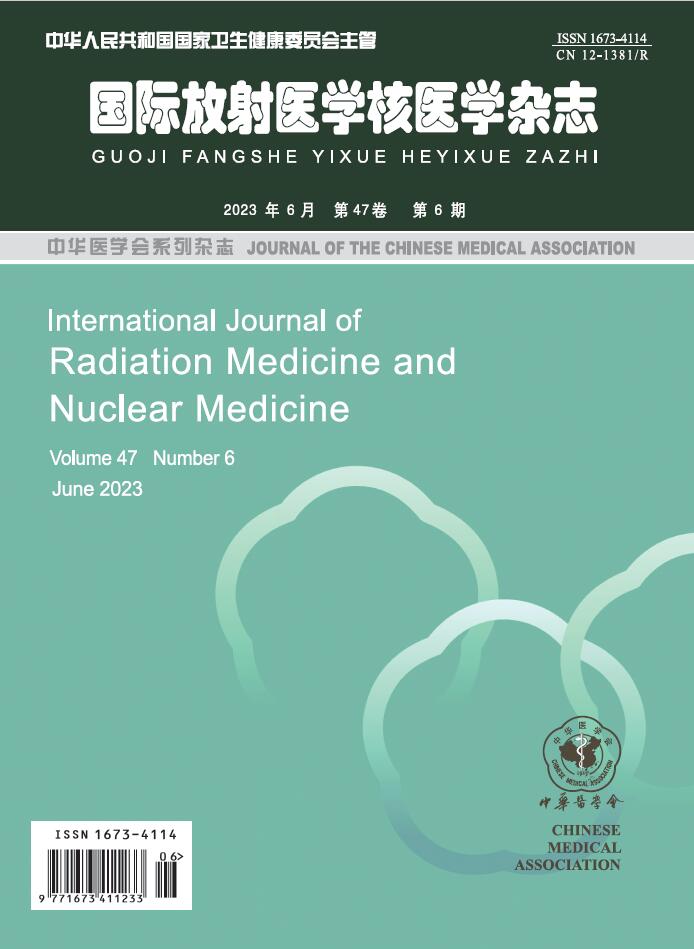-
近年来,尽管经皮冠状动脉介入治疗(percutaneous coronary intervention,PCI)有效降低了急性心肌梗死(acute myocardial infarction,AMI)患者的病死率,但AMI仍为目前冠状动脉粥样硬化性心脏病(简称冠心病)患者致死、致残的主要病因[1]。行PCI的目的在于挽救濒死心肌,改善AMI患者的预后。心肌挽救量(myocardial salvage,MS)对于PCI的疗效评估及预后判断具有重要价值[2]。由MS与初始心肌危险区面积(area at risk,AAR)的比值获得的心肌挽救指数(myocardial salvage index,MSI)是AMI患者行PCI是否获益的独立预测因子[3]。
门控SPECT心肌灌注显像(gated SPECT myocardial perfusion imaging,GSMPI)通过计算机软件自动处理可“一站式”获得血流灌注参数及多项功能参数[4]。在急诊PCI前注射显像剂99Tcm-MIBI行GSMPI检测AMI患者的初始心肌AAR的方法的临床价值已在早期的大样本研究中得到验证[5-6],通过与PCI后再次显像获得的心肌最终梗死面积(final infarction size,FIS)进行比较可获得MS及MSI。一项对765例AMI患者的大样本研究结果表明,经再灌注治疗后MSI<0.5的AMI患者,其6个月病死率明显高于MSI≥0.5者;MSI与AMI患者的6个月病死率呈独立相关,MSI能够预测AMI患者的6个月病死率[5]。该研究结果还显示,在用于测试AMI患者再灌注治疗疗效的临床试验中,MSI可作为病死率的替代指标,尤其是对于新治疗方案的有效性的判断,能够明显降低对样本量的要求,且可行性更佳。然而,临床实践中在急诊时行GSMPI通常很难实现,原因包括:核素显像剂难以及时供应、大多数单位不具备夜间急诊条件、核医学科距离急诊科或胸痛中心较远等,以上原因导致GSMPI在AMI患者急诊时的应用受到限制[3, 7-8]。
近年来有学者提出,利用AMI患者行PCI后早期心肌顿抑的原理,通过PCI后早期行1次静息状态下GSMPI即可间接获得AAR[9-12],从而实现对MS及MSI的定量评估,该方法的结果与2次显像法的一致性很好,且操作简便,同时降低了辐射剂量及检查费用,实用价值明显提高,对AMI患者的危险度分层、个体化治疗方案制定、疗效评价、预后判断具有重要价值。笔者拟对该新显像方案的机制、应用价值、优势及发展前景作一综述。
-
AMI发生后,梗死相关冠状动脉闭塞导致的心肌缺血区,即初始心肌AAR,包括不可逆心肌损伤区(也称心肌FIS)和可逆性心肌损伤区(也称MS)。准确评估AAR及FIS是获得MS的前提。
AMI患者行PCI后早期存在心肌顿抑现象[13],即PCI使血流恢复正常后,心室壁收缩功能障碍尚未恢复。早期的一项超声研究结果显示,这种室壁收缩异常于PCI后48 h左右开始恢复,并将持续数日至数周才逐渐恢复正常[14]。Main等[15]的研究结果也表明,AMI后平均2.2 d仍可识别出这种“灌注-功能不匹配”的顿抑心肌。因此,在PCI术后早期,特别是2~3 d内,在心肌顿抑仍未恢复时检测出的室壁收缩异常范围,即可代表PCI前的初始心肌AAR。研究者正是利用这一原理,于PCI术后早期行GSMPI,并通过门控采集方式,由计算机软件自动获得心室壁收缩功能参数,识别收缩异常的心肌节段,从而计算室壁收缩异常的范围,间接获得AAR[11-12]。
另外,AMI患者行PCI后FIS的评估时间也是一个关键问题。尽管有研究者于PCI术后2 d行GSMPI检测AMI患者的FIS以评价不同药物的疗效[16],但更多的研究者选择出院前或PCI术后至少1周,甚至1个月或数月再行评估[17-19]。Pellikka等[20]在早期研究中对AMI患者分别于PCI前、治疗后18~48 h及6~14 d行GSMPI,并比较治疗后不同时期血流灌注的改善情况,结果显示,术后18~48 h的低灌注区较术前改善,但6~14 d血流灌注进一步改善,改善的程度到后期才更明显。另外一项动物实验结果也表明,AMI后过早行GSMPI评估很可能会高估FIS,术后1周左右评估的准确性更高[21]。Ndrepepa等[22]通过对1312例ST段抬高型心肌梗死(ST-segment elevation myocardial infarction,STEMI)患者于PCI术后7~14 d行GSMPI,获得心肌FIS,从而获得MS。
然而,确定MS的最佳评估时间需权衡AAR及FIS 2个方面的因素,因此有学者提出,选择48 h至1周行GSMPI可以同时获得AAR及FIS,是检测MS的最佳时间点[12]。Tanaka和Nakamura [23]观察了AMI患者再灌注后不同时段(30 min,6 h,1、4、20 d)心肌血流灌注的改善情况,研究结果提示,再灌注治疗后7 d左右行99Tcm-MIBI GSMPI评估MS最佳。Calabretta等[7]对AMI患者于PCI术后3~5 d行GSMPI,获得MS,并证实了其可行性及临床价值。
-
Wakabayashi等[9]通过对AMI模型鼠再灌注后3 d行99Tcm-MIBI GSMPI获得AAR,评估心肌受体在缺血再灌注后的表达情况,结果证实了该方法的可行性及有效性。另外,Qin等[10]通过对STEMI患者PCI术后24 h至7 d行GSMPI获得AAR,并计算得到MS及MSI,结果证实了MS及MSI能够用于评价心肌缺血再灌注损伤的程度。
Sotgia等[11]的研究纳入了48例AMI患者,于PCI术后5~10 d行1次静息99Tcm-MIBI GSMPI,以室壁增厚率异常范围替代AAR,并与血流灌注异常范围相减获得MS,通过与PCI术前、术后2次显像灌注受损面积相减所得的MS进行比较,结果证实了二者所得结果具有很好的相关性,仅PCI后1次99Tcm-MIBI GSMPI即可实现对MS的评估,用室壁增厚率异常范围可替代PCI术前的AAR,以此计算MS的优势在于该方法的可行性明显提高。
在另一项类似的研究中,36例AMI患者于PCI术前注射显像剂,于PCI术后6 h行第1次GSMPI,5 d后再次显像,2次显像血流灌注异常范围相减获得MS,结果显示,其与术后5 d 1次GSMPI室壁增厚率异常范围与血流灌注异常范围相减获得的MS相当(Spearman等级相关系数为0.92,P<0.0001),且二者对患者预后进行分类的结果一致性良好 (Kappa值=0.75)[12]。该项研究的作者认为,术后1次显像法评估MS将有益于对AMI患者不同治疗策略的效果评价。
Calabretta等[7]直接利用PCI术后3~5 d行1次GSMPI的方案计算MS,并探讨了MS对STEMI患者PCI术后6个月心功能恢复情况的预测价值。该研究中120例STEMI患者于PCI术后3~5 d行1次GSMPI,获得MS、FIS及术后早期左心室射血分数(left ventricular ejection fraction,LVEF),并于患者出院后6个月复查GSMPI,再次获得LVEF。ROC曲线分析结果表明,MS能够预测PCI术后LVEF的恢复程度(AUC=0.79,P<0.0001);以23%为临界值,MS预测LVEF恢复程度的灵敏度和特异度分别为74%和71%,而FIS与LVEF恢复程度无明显的相关性(AUC=0.53)。
-
近年来有研究者通过注射脂肪酸显像剂123I-β-甲基-p-碘苯基十五烷酸(123I-β-methyl-p-iodophenyl pentadecanoic acid,BMIPP)行GSMPI获得AAR,后行99Tcm-MIBI GSMPI获得FIS,将二者相减获得MS,并证实了该方法用于计算MS的可行性[3, 8]。AMI发生后,缺血心肌的能量来源由脂肪酸转变为葡萄糖,且缺血心肌的脂肪酸β氧化水平在心肌缺血发生后将持续降低,因此,应用脂肪酸显像剂123I-BMIPP于AMI后行 GSMPI所显示的显像剂摄取减低区即接近于AAR。研究结果显示,PCI术后1~2周行123I-BMIPP GSMPI,获得的AAR与急诊时于PCI术前行99Tcm-MIBI GSMPI所得的结果相当[23]。然而,由于123I-BMIPP的获得较为困难,导致其在临床中的应用受到限制。
-
CMR具有较高的空间分辨率,通过对AMI患者PCI后1周左右行T2加权成像可实现对AAR的检测,联合延迟增强扫描可获得FIS,从而可计算得到MS[24]。其中,准确定量AAR是获得MS的重要前提,也是研究的难点。
CMR检测AAR的标准化技术为T2加权成像,其中T2加权短时间反转恢复序列(T2-STIR)的组织对比度更佳[25]。研究者将T2加权短时间反转恢复序列(T2-STIR)及对比度增强的稳态自由进动成像(CE-SSFP)获得的AAR与GSMPI所得结果进行比较,发现二者与GSMPI所得结果均具有良好的一致性(r=0.81,P<0.001;r=0.86,P<0.001)[26]。另有研究结果显示,GSMPI与MRI对于透壁性心肌梗死的评价一致性良好,但对于未完全坏死仍存活的心肌,GSMPI较MRI明显高估了MS[27]。
然而也有研究者发现,T2加权成像易低估AAR,且T2加权短时间反转恢复序列(T2-STIR)无法完全抑制心内膜下“慢血流”效应,易出现高信号伪影,导致过度诊断[28]。因此,T2加权成像技术测量AAR的准确性及可重复性有待进一步研究证实。近年来,随着纵向弛豫时间定量成像(T1 mapping)、横向弛豫时间定量成像(T2 mapping)技术的发展,CMR可更加客观、准确地评估AAR[29],其中T1 mapping具有更高的灵敏度,T2 mapping在降低伪影干扰上具有明显的优势,且能够直观地显示心肌水肿的变化,但结果受MR扫描仪场强、MR序列及心肌节段等因素的影响较大,其测量一致性仍需进一步提高,以上原因均导致目前其在临床中的实际应用受到限制[30]。此外,某些特殊人群,如幽闭恐惧症及体内有金属植入物无法行MRI的患者,行CMR存在困难;且并非所有医院都能实现这种理想的成像模式,加之CMR对操作者本身的要求较高等,均限制了其在临床中的普遍开展。
-
研究结果显示,应用82Rb PET心肌灌注显像评估AMI患者行PCI后的MS是可行的,通过1次显像即可获得AAR、FIS、MS以及心功能等多项定量参数[31]。Ghotbi 等[32]将82Rb PET显像与GSMPI、CMR测定的MS结果进行对比,结果显示PET获得的AAR、FIS均低于GSMPI及CMR,而3种方法获得的MSI的差异无统计学意义。
但是,PET显像的成本较高,核素的获得相对较困难。研究结果表明,当PCI术后早期PET显像显示的灌注缺损与AAR的一致性不能确定时,需要进行第2次PET显像[24]。以上原因均限制了82Rb PET显像在MS测定中的临床应用。
-
综上,无创性量化AMI患者的MS具有重要的临床价值,GSMPI是冠心病诊疗中的常用检查方法,其优势在于可通过简单的方法“一站式”获得血流灌注、心功能等多项信息,而GSMPI用于AMI患者MS及MSI的评估,能够为患者出院前的危险度分层提供补充信息,同时为后续个体化随访计划的制定及用药指导提供更多的参考依据。未来仍需更大样本量的研究以评价GSMPI在AMI患者疗效评估及预后判断中的临床价值。
随着核医学显像设备的不断更新,碲锌镉心脏专用SPECT仪已投入临床使用,其能将图像的空间分辨率大大提高,同时降低显像剂的注射剂量,缩短采集时间,最终获得更加优质的图像[33]。因此,未来GSMPI在AMI的诊疗中将发挥更广泛的评估作用,其应用前景值得期待。
利益冲突 所有作者声明无利益冲突
作者贡献声明 李婷负责综述命题的提出、文献的收集、综述的撰写和最终版本的修订;黄遵花、苏学晓负责综述部分内容思路的提出、文献的收集
Research progress of gated SPECT myocardial perfusion imaging in evaluating myocardial salvage in patients with acute myocardial infarction
- Received Date: 2022-07-28
- Available Online: 2023-06-25
Abstract: The purpose of percutaneous coronary intervention (PCI) in patients with acute myocardial infarction (AMI) is to save dying myocardium as much as possible. The amount of myocardial salvage (MS) is closely related to whether the patients benefit from the PCI. MS is of great value for PCI efficacy evaluation and prognosis. To assess MS, the initial myocardial area at risk (AAR) before PCI and the final infarction size (FIS) after PCI should be determined, and the difference between the two is called MS. AAR and FIS can be quantified by double 99Tcm-methoxy-isobutyl-isonitrile gated SPECT myocardial perfusion imaging (GSMPI) on emergency admission and after PCI, respectively. The results are objective and accurate, and its clinical value has been confirmed in early large sample studies. However, emergency GSMPI has many limitations that make AAR difficult to obtain. In recent years, some scholars proposed that the only one GSMPI method early after PCI could replace double imaging method for MS evaluation, which significantly improved the feasibility and expanded the application extent of GSMPI in the diagnosis and treatment of AMI, and provided supplementary information for risk stratification in patients with AMI. The principle, application value, advantages and development prospect of the new method for evaluating MS in AMI patients are reviewed by authors.








 DownLoad:
DownLoad: